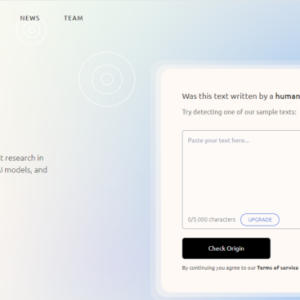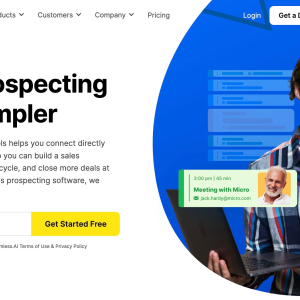In the fast-paced world of e-commerce, staying ahead of the competition and achieving unstoppable growth is a constant challenge. One tool that has revolutionized the way businesses interact with their customers is ChatGPT. Powered by artificial intelligence, ChatGPT allows businesses to offer personalized and seamless conversations with their customers, enhancing customer experience and driving sales. In this article, we will explore ten ingenious ideas on how to leverage ChatGPT for e-commerce to achieve unstoppable growth. Whether you are a small startup or an established e-commerce giant, these ideas will help you harness the power of ChatGPT to take your business to new heights.
- Contentbot Review: Is This Content Writing Tool Worth It?
- Synthesia.io Review: An AI Video Creation Tool That Help Grow Your Business?
- 11 Midjourney Alternatives That Will Help Expand Your AI Creativity
- 6 AI Joke Generator Options: Can Artificial Intelligence Make You Laugh?
- Which Is The Best Next-Gen AI Website Builder?
Welcome to my blog post on how to use ChatGPT for e-commerce!
You are viewing: How To Use ChatGPT for E-commerce: 10 Ingenious Ideas For Unstoppable Growth
With e-commerce sales predicted to hit an astonishing $6.3 trillion by 2024, it’s clear that the future of shopping lies online.
Amidst this virtual gold rush, how can your business shine like a rare gem among countless imitations?
Welcome to ChatGPT – your secret weapon in the quest for e-commerce domination.
Curious to see how ChatGPT can turbocharge your e-commerce strategy?
Let’s dive in!
1. Delve into the Market
Kick things off by asking ChatGPT about the market you’re tapping into. For example, let’s say you’re interested in opening up a pet products ecommerce business.
ChatGPT can supply you with pertinent statistics, like the industry’s size and growth trajectory.
For instance, the pet products market in the U.S. is valued at over $100 billion and is expected to keep growing in the coming years.
Consequently, understanding the current market scenario empowers you to choose a lucrative niche.
2. Spot Trends and Segment Opportunities

Carving out your own unique positioning requires knowledge of the latest trends.
ChatGPT can help you identify thriving market segments, such as pet food, pet care items, pet toys, and pet grooming essentials.
Moreover, it can offer insights into consumer preferences, like the increasing appetite for high-quality, organic, eco-friendly products.
As a result, staying up to date with these trends ensures that you’re well-equipped to serve the needs of your target audience.
3. Gauge the Competition
Knowing your competition is key to succeeding in any market.
Tell ChatGPT:
“Give me a market analysis on the pet product e-commerce market in the United States. Then, focus on the competition in the space.”
ChatGPT can help you identify significant players in the industry, like Chewy, PetSmart, Petco, and Amazon.
However, don’t be intimidated by these giants; there’s still ample room for niche businesses focusing on specific products or target audiences.
One of the best tools to do help you with this process is Jungle Scout.
You’ll gain valuable insights into the market size, competitive analysis, niche opportunities, and TON more.
And understanding your competition allows you to create a unique selling proposition (USP) that sets you apart and appeals to your target customers.
Create a Unique Selling Proposition
Ask ChatGPT to pinpoint a “niche within a niche” or a “submarket” for your desired niche.
For example, if you want to differentiate yourself in the pet market, you could focus on city dogs. Urban dwellers and their furry companions face various issues that suburban or rural dogs may not encounter.
From limited space to noise restrictions, urban canines require specific products and services to thrive in the concrete jungle.
As you develop your one-of-a-kind selling proposition, you should concentrate on critical aspects of your submarket.
For the city dogs market, that would be:
- Limited Space
- Noise Restrictions
- Lack of Green Spaces
- Urban Safety
- Loneliness and Boredom
- Dog Services
Get the idea? Now, go forth and apply this to your market!
4. Crunch the Numbers
Starting an e-commerce business requires a financial investment, and ChatGPT can help you estimate the costs involved.
It can provide a ballpark initial investment figure, ranging from $2,000 to $10,000, depending on your inventory, marketing, and other requirements.
ChatGPT can also offer insights into ongoing costs, such as inventory management, shipping, marketing, and Shopify subscription fees.
Armed with this information, you can create a realistic budget.
5. Customer support

See more : Best eDiscovery Software? 7 Document Review Options & Tips To Help You Decide
Customer support plays a vital role in eCommerce success, with 92% of customers believing that effective and timely support is crucial for fostering brand loyalty (Microsoft).
A staggering 32% of customers will switch brands after just one poor customer support experience (PwC).
FAQ and Knowledge Base Enhancement
With ChatGPT on your side, you can whip up top-notch answers to common questions. This empowers your customers to find solutions independently and reduces the demand for direct support.
Got an existing store? Feed ChatGPT your most frequent customer inquiries and watch it churn out insightful, useful replies that keep your customers well-informed.
Just kicking off your e-commerce journey? No worries! You can enlist ChatGPT to dream up the questions too, setting you up for success from the get-go.
Here’s what ChatGPT gave me when I prompted it for common e-commerce FAQs!
Chatbot Integration
Ready to revolutionize your e-commerce brand’s customer experience?
Harness the power of ChatGPT to leverage an AI chatbot that tackles FAQs, troubleshoots issues, and guides customers through their shopping journey.
Not only will this ease your workload, but it’ll also create a seamless experience for your customers (who will wag their tails in delight.)
Here’s the lowdown on how to bring this to life:
- Snag ChatGPT API access: Get cozy with the API documentation, requirements, and best practices, so you’re all set for smooth integration.
- Fetch developer help: Partner with an in-house or external development team to tackle the technical side of integrating ChatGPT into your platform.
- Customize your chatbot’s bark: Shape ChatGPT’s language, tone, and responses to match your brand’s identity and resonate with your target audience.
- Unleash ChatGPT across customer touchpoints: Weave ChatGPT into live chat, help centers, product pages, and email support, providing personalized assistance that’s always on the ball.
- Test and optimize: Conduct thorough testing, gather feedback, and fine-tune your ChatGPT-enhanced customer support for top-dog results.
6. Drive Traffic to Your Store Through Search

Search engines are your best friends when driving traffic to your e-commerce store. But how can you harness the power of ChatGPT to catapult your site to the top of search results?
First, you must master keyword research to understand what your potential customers are searching for.
ChatGPT can help you generate a list of relevant keywords by providing it with your niche and target audience details. Uncovering these hidden gems allows you to optimize your content and reach the top of search results.
Secondly, focus on long-tail keywords, which offer a lucrative opportunity to attract highly-targeted traffic ready to buy. These longer, more specific phrases may have lower search volumes but often lead to higher conversion rates. ChatGPT can assist you in identifying these long-tail opportunities, allowing you to optimize your content.
Great content is essential for any successful eCommerce store. With ChatGPT, you can effortlessly craft engaging, informative, and SEO-friendly content that appeals to humans and search engine algorithms.
Also, remember the importance of meta tags. They might not be visible to users, but they are vital to your search engine performance.
ChatGPT can help you generate enticing meta titles and descriptions infused with your target keywords. This can improve your click-through rates and send positive signals to search engines.
Lastly, building a solid backlink profile is essential for achieving search engine stardom. ChatGPT can help you brainstorm innovative link-building strategies, such as guest posting opportunities, expert roundups, and resource pages.
With these creative ideas, you can develop a robust backlink profile that propels your store to the top of Google.
7. High-converting Product Descriptions
Mastering high-converting product descriptions is essential, as it can be the decisive factor between a customer choosing to purchase or pass.
Follow these six steps and transform your descriptions into persuasive sales tools with ChatGPT:
Step 1: Research and Analyze Competitors
Begin by researching and analyzing your competitors’ product descriptions. Identify what works well, what doesn’t, and any gaps in their content you can address. Take note of phrases or terms that convey benefits.
Step 2: List Product Features and Translate Them into Benefits
Next, make a comprehensive list of your product’s features. Then, translate each feature into a benefit that resonates with your target audience. For example, if your product is a pet bed with a waterproof cover, the benefit could be “easy to clean and maintain.”
Step 3: Identify Your Unique Selling Proposition (USP)
Determine what sets your product apart from the competition. It could be superior quality, unique design, or additional features that make your product stand out. This USP will be a key focal point in your product description.
Step 4: Develop a Buyer Persona
Create a detailed buyer persona to understand your target audience better. This will help you tailor your product description to address their needs, desires, and pain points.
Step 5: Determine Your Brand Voice
Define the tone and voice that best represent your brand. This will ensure consistency across all your content and help customers feel who you are and what you stand for.
Step 6: Craft the ChatGPT Prompt
Next, create a comprehensive ChatGPT prompt incorporating your research and insights. Include your product features and benefits, USP, buyer persona, and desired brand voice.
Example Prompt
See more : Understanding LLM Fine-Tuning: Tailoring Large Language Models to Your Unique Requirements
“Write a high-converting product description for ‘Fido’s Ultimate Chew Toy,’ a dog toy designed for aggressive chewers. Features include its durability, dental health benefits, and engaging shape. Our unique selling proposition is the toy’s ability to withstand even the toughest chewers while promoting dental health. The target audience is dog owners who struggle to find long-lasting chew toys for their large dogs. Please maintain a fun, engaging, and reassuring tone.”
8. Generate Imagery with DALL-E

Looking to make a splash in your e-commerce market? Combine the prowess of ChatGPT with DALL-E to create eye-catching, custom visuals for your products and marketing campaigns.
By providing detailed descriptions of the desired images, you can let DALL-E whip up unique visuals that’ll set your brand apart from the pack.
Identify the Visual Elements

To kick things off, identify the visual elements that embody your e-commerce brand’s unique style, target audience, and messaging.
Once you have a clear vision, craft a detailed prompt describing the image you want to create. Be specific about colors, objects, and the overall vibe.
For example, let’s say you’re building out the branding images on your store.
Your prompt could be:
“An adorable French Bulldog on a rooftop terrace in New York City. The scene should evoke a sense of urban chic, with the city skyline in the background and a warm, golden sunset.”
Fine Tune Your Prompt
While DALL-E takes care of the imagery, ChatGPT can help fine-tune your initial prompt to ensure it’s crystal clear and primed for DALL-E.
Pop your descriptive prompt into ChatGPT, asking for suggestions to sharpen it up.
Review the recommendations from ChatGPT, and apply the changes to your prompt accordingly. Nailing this step is crucial to harness the full potential of DALL-E.
Next, it’s time to feed it to DALL-E and let the magic happen. Check the generated image to ensure it meets your expectations. If it’s not quite there yet, don’t sweat it!
Lastly, tweak your prompt to provide clearer or more specific instructions, and give DALL-E another whirl. Then, keep iterating until you achieve the perfect result, and watch as your e-commerce brand makes a bold visual statement.
9. Social Media Content Ideas

Struggling with writer’s block on social media? Use ChatGPT as an idea generator! (Read our in-depth guide on brainstorming with ChatGPT.)
Feed it your target audience, product niche, and preferred social platform, and it’ll generate unlimited content ideas to keep your followers coming back for more.
To get your ideas flowing, here are some example prompts you could ask ChatGPT:
- “Generate five funny social media post ideas featuring city dogs struggling with urban life, like small apartment spaces or lack of green areas to play.”
- “Create humorous captions for a series of images featuring city dogs wearing fashionable outfits, interacting with urban surroundings in a quirky manner.”
- “Write three witty social media content ideas that play on the challenges of walking a city dog in crowded streets, with a light-hearted and relatable tone.”
- “Provide a few amusing social media post concepts showcasing city dogs trying to navigate various public transportation options, like buses or subways.”
- “Come up with a set of entertaining social media content ideas highlighting the unanticipated friendships city dogs make with other urban animals like pigeons or squirrels.”
10. Create email Flows

Leverage ChatGPT to create captivating email flows for your e-commerce brand! By focusing on welcome emails, abandoned cart flows, and post-purchase flows, you’ll effectively engage with your customers and keep them returning for more.
Read more about ChatGPT for email marketing.
Welcome Emails
According to a study by Invesp, welcome emails generate 320% more revenue per email than other promotional emails, emphasizing their crucial role in establishing a strong relationship with customers and driving sales for your e-commerce brand.
For example, input a prompt like:
“Create a welcome email for our pet e-commerce brand that introduces our unique products and mission while offering a special discount.”
With a well-crafted welcome email, you’ll instantly connect with customers, showcasing the value of your brand and sparking interest in your tailored solutions.
Abandoned Cart Flows
Don’t let those abandoned carts slip through your fingers! With a staggering $4.6 trillion in sales lost annually, addressing this issue is crucial for e-commerce brands.
Remember, turning the tide on abandoned carts could transform a break-even or losing marketing campaign into a profitable one.
Ask ChatGPT to help you create a compelling email that nudges customers to complete their purchases.
Input a prompt such as:
“Write an abandoned cart email for our pet e-commerce brand that highlights the benefits of our products and offers a limited-time incentive to encourage customers to complete their purchase.”
These targeted emails will remind customers of your value and help convert those almost sales into loyal customers.
Post-Purchase Flows
According to Shopify, repeat customers account for an average of 41% of a store’s revenue.
Keep the conversation going with ChatGPT-generated post-purchase emails.
Try a prompt like:
“Create a post-purchase email for our pet e-commerce brand that thanks the customer, offers tips on using the product, and invites them to share their experiences on social media.”
How to Use ChatGPT for Ecommerce – Final Thoughts
From identifying lucrative submarkets to crafting engaging content, creating visually stunning imagery, and offering exceptional customer support, AI-driven tools like ChatGPT and DALL-E empower you to refine every aspect of your business, ultimately leading to increased conversions and a loyal customer base.
As you reflect on the possibilities these tools offer, consider how embracing AI-driven solutions can help your e-commerce business thrive and redefine the value you provide to your customers.
That concludes the article: How To Use ChatGPT for E-commerce: 10 Ingenious Ideas For Unstoppable Growth
I hope this article has provided you with valuable knowledge. If you find it useful, feel free to leave a comment and recommend our website!
Click here to read other interesting articles: AI
Source: duanetoops.com
#ChatGPT #Ecommerce #Ingenious #Ideas #Unstoppable #Growth
Source: https://duanetoops.com
Category: AI





